By Ali Al-Baroodi
The city of Mosul in Iraq encloses the ruins of the ancient city of Nineveh, which was once the capital of the Assyrian Empire. Assyrian civilisation celebrated art, culture, and beauty in various ways and shapes, but sculpture was a dominating feature of the palaces later excavated by western expeditions. The statues and palace reliefs documented kings, gods, and religious rituals – and archaeological expeditions are still finding new sculptures up to this day. This rich cultural history, however, is no longer as present in Mosul. The lamassu, or winged bulls, which were once celebrated as the protectors of the gates of the empire, are now gone, either scattered across the globe in museums, or destroyed by the Islamic State (IS) during its vicious occupation of Mosul. Today, replicas stand in their place.
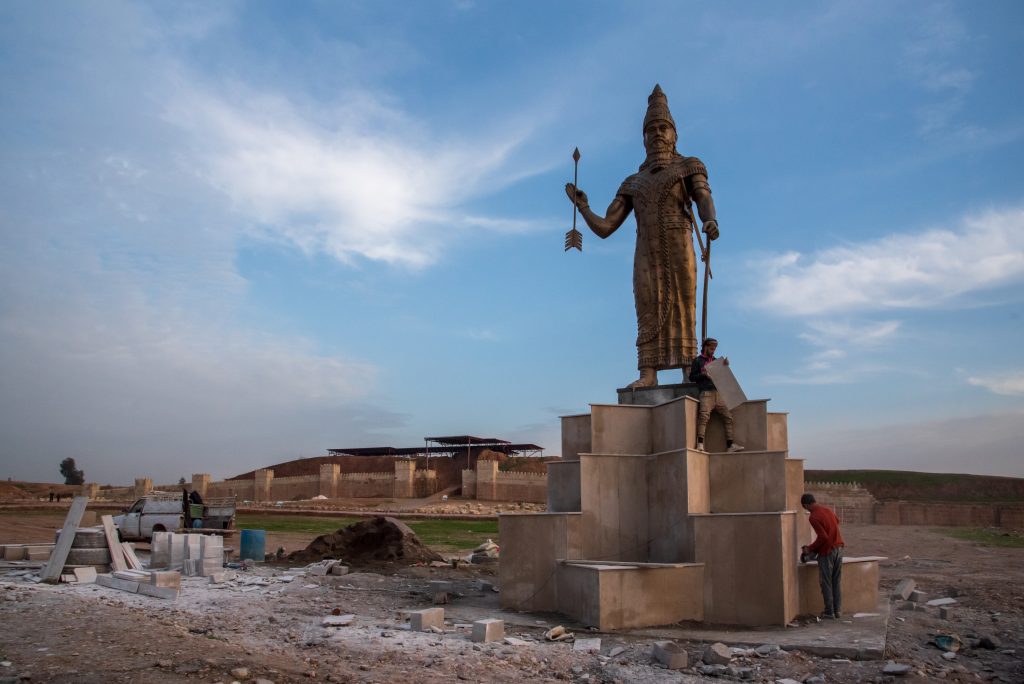
The King Synchrib Statue by sculptor Omar Kais. Credit: Ali Al-Baroodi
Mosul’s statues
For many Moslawis, statues were a key part of daily life. The Liquorice vendor statue, the Jar carrier, and the Hatra Falcon all gave their squares a name – Be’e Al-Soos, Hamilat Al-Jerar, and Sahat Suqoor Al-Hadhar – and became distinctive marks in the city’s urban map. I spoke to the famous sculptor, Talal Saffawi, in January 2024 about his work and experience in this field of art. Saffawi started his sculpting career in the 1970s, after graduating from art school in Baghdad. ‘Sculptures were a form of art that has always been celebrated and accepted publicly’, Saffawi said. ‘We used to work with bronze and installed many of my sculptural works in Mosul & Basra’.
Saffawi’s works were installed across the country, but he is better known for his local ones – including the Liquorice vendor statue – which embody themes such as folklore, historical figures from the Abbasid times, the poet Abi Tammam Al-Taee, and heritage symbols like the ancient Moslawi vessel, a small pot used to pour water into people’s hands after eating. These works were not the only ones to adorn Mosul. As the 1970s brought a rise in prosperity to Iraq, art was one of many fields that began to develop. Sculptors from across Iraq came to Mosul – known for centuries as a hub for artists – to carve their names on the public space and to leave behind a record of the city’s culture and history.
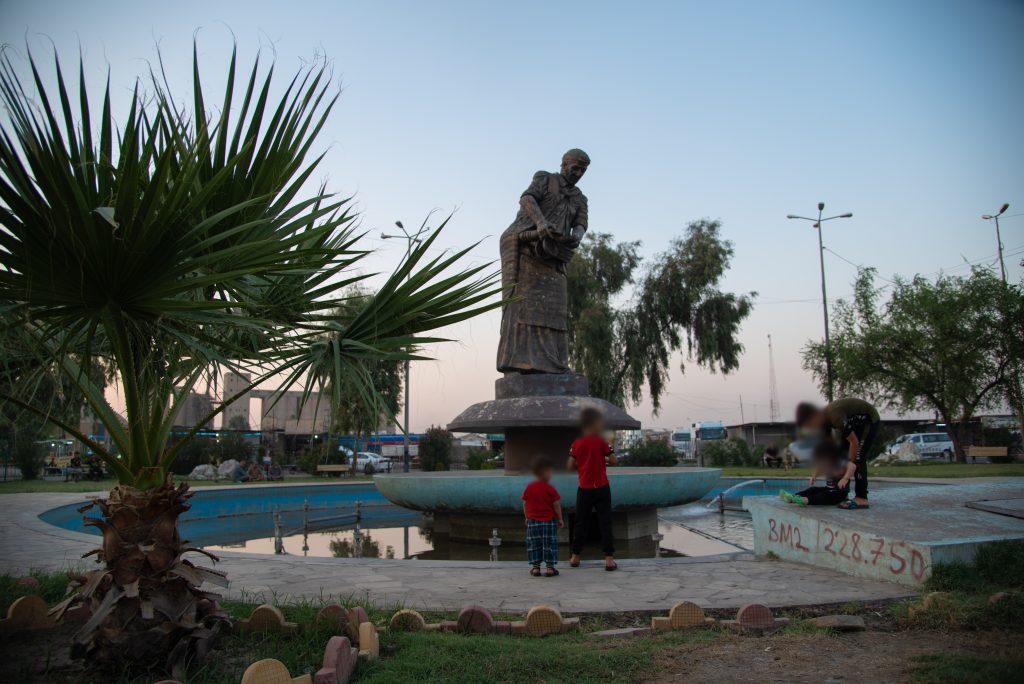
The liquorice statue square, September 2020. Credit: Ali Al-Baroodi
When Saddam Hussein seized control of the Ba’ath party in 1979, a different era in Iraq’s history began, as the dictator dominated the country with hundreds of statues of himself. An abiding image of the Iraq war is the fall of the statue of Hussein on 9th April 2003, when Iraq fell to US forces. This was soon followed by the removal of most statues of that era as they were pulled down and demolished by angry Iraqis.
When Mosul was captured by IS in June 2014, statues were again targeted. This time, however, IS started removing and destroying the sculptures as part of its attack on the city’s heritage and identity, calling them ‘something similar to pre-Islam idols that people worshipped’.[i] The squares in Mosul became dull. Some were turned into ugly IS centres to broadcast the group’s atrocities on big screens. ‘It was a painful thing to witness’, Saffawi recalls. ‘Seeing my works turn into rubble felt exactly like losing a member of my family. I bitterly experienced both’, he chokes.

The base of the Spring Lady statue in Mosul Downtown, after IS destroyed the statue. This photo was taken in November 2017, after Mosul’s liberation from IS. Credit: Ali Al-Baroodi
By the time Mosul was declared free of IS in July 2017, the city had suffered significant cultural and heritage losses. IS deliberately destroyed 47 architectural sites, and an estimated 10,000 buildings were damaged or destroyed in the course of the war – half of these stood in the Old Town, which was the site of a devastating battle to liberate the city.[ii] When rebuilding started, the work concentrated on repairing the hugely damaged infrastructure.
‘At the beginning, we focused on resuming basic life needs and infrastructures,’ Ala’a Al-hayder, a Mosul municipality media spokesman said. ‘Years later, after we managed to stand back on our feet, we decided to bring Mosul back to its modern urban nature and reinstall statues. It started happening as we resorted to young sculptors who rolled up their sleeves to remake the demolished statues and even create new ones’. For many Moslawis, the local authorities’ call to remake and reinstall the statues was greeted with satisfaction. In Mosul, the statues, and the squares that housed them, are deeply rooted in the public urban memory. Restoring them was a way of restoring the city’s identity and creating a sense of belonging.
‘These statues are not just pieces of stone’
Most of the statues are now back in their squares, and new ones have even been added to the spaces of Mosul. These statues are not just pieces of stone and structures. They are part of the urban memory of the city. To learn more about the reinstalment of statues, I met with Thabit Michael, a sculptor from Qaraqosh, in the Nineveh plains. He made sure to recreate one of Mosul’s most iconic statues, the Spring Lady, which was removed by IS. The Spring Lady lay in the heart of Mosul, and for many it was part of the city’s identity – Mosul is known as ‘the city of two springs’ because of its mild climate in autumn and spring. The new statue now stands tall in Mosul Downtown. ’My sculptural works are stemmed from the ancient and modern Iraqi artistic values’, Michael told me. His spring lady statue is a replica of the original, and for Michael, it was ‘important to bring it back’.
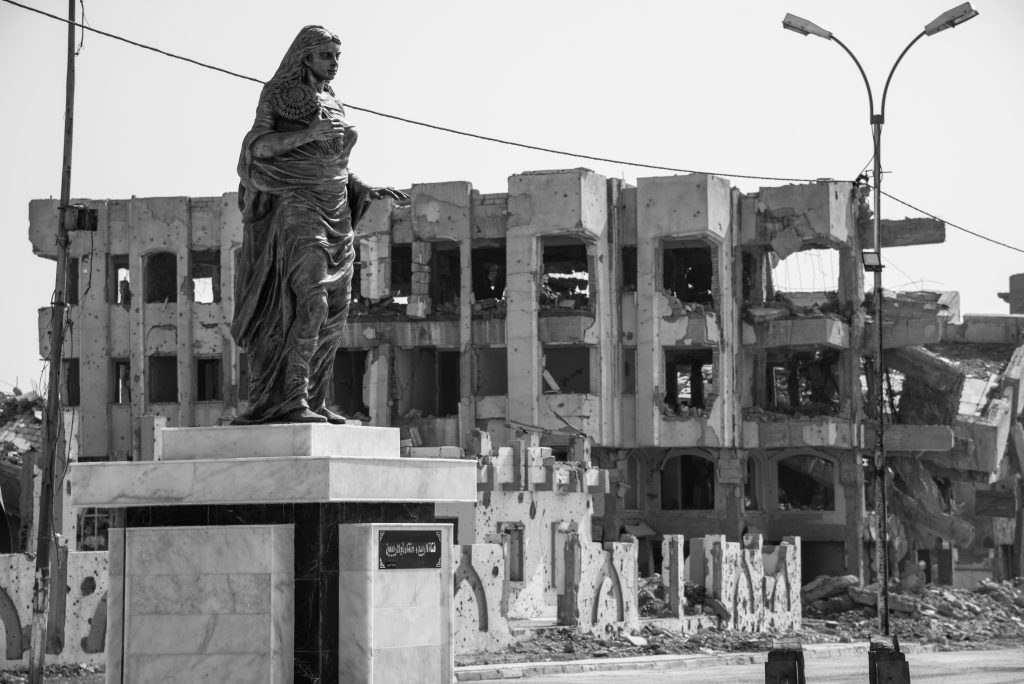
The Spring Lady statue by sculptor Thabit Michael. Credit: Ali Al-Baroodi
Thabit has managed to install many other statues in Nineveh’s churches, monasteries, and public spaces. One particularly symbolic work stands on the gates of his hometown, from which all the indigenous people, Michael included, were displaced by IS in August 2014: ‘It’s a local woman with a folkloric costume carrying the key to return and welcoming the visitors after years of displacement’. For Michael, statues are a way to mark the past and to tell the story of Iraq to future generations.

The Return statue in Bakhdeda, Nineveh Plains. Credit: Thabit Michael
Omar Kais teaches Arts and Sculpture at the Institute of Fine Arts in the city, and is one of many young sculptors who is working on creating new statues for Mosul’s public spaces. In 2018, he built the iconic Beautiful Lady statue in a square which had been used by IS to screen its atrocities. Kais has also remade the statue of Mulla Othman Al-Mosuli, the celebrated Moslawi musician, composer, and poet, and two statues of the famous lamassu. He is now working on making a new statue of King Synchrib of Assyria. I visited the site next to the Nineveh historical wall where the workers were still putting the finishing touches on the base of the statue. This very site was a theatre upon which IS marched after taking Mosul in 2014, and later became a heritage crime scene when the militants demolished all the Assyrian gates and bulldozed the historical wall.
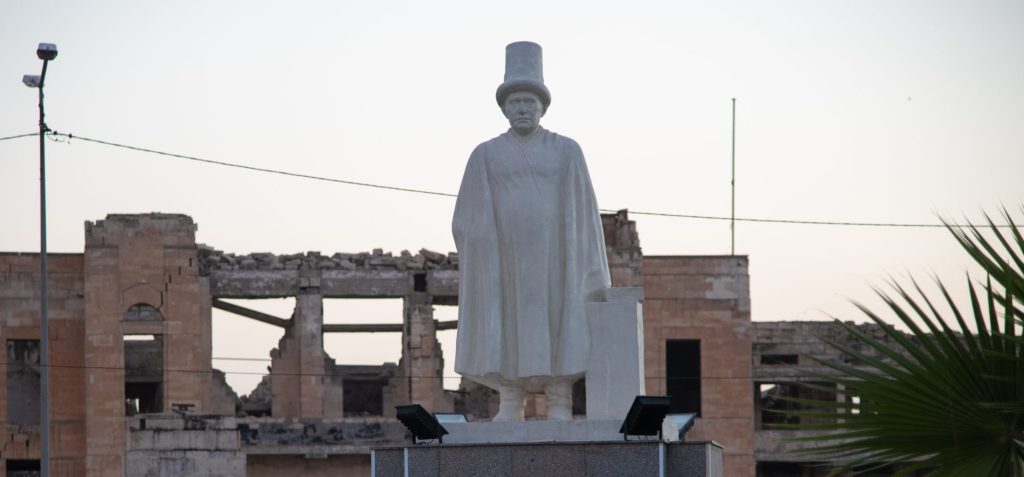
Othman Al-Mosuli statue by sculptor Omar Kais. Credit: Ali Al-Baroodi
With the new statue, however, Kais is offering the square a chance at rehabilitation, to display a different part of the province’s history: ‘Assyria was an empire in the ancient time that we are now living on. I chose King Synchrib for his great achievements like watering systems, palaces, and much more’. This desire to reimagine runs in the family – Kais’ father uses scrap metals to create new symbols. For Kais, ‘sculpture is a way of life that started as a hobby and turned into a profession’. When Pope Francis visited Mosul in 2021, Kais was selected to create a medallion displaying the city’s demolished monuments to present to the pontiff.
The revival of public space
The local spaces of Mosul have now become more thematically diverse as other sculptors have used their work to reflect on the events of the city’s recent history. A statue of ‘the Worker’ has been built to hail all the people involved in reviving life in post-IS Mosul, while a long wall mural gives an account of Nineveh and Mosul’s history. Mosul’s spokesman, Al-Hayder, also assured me that there will be ‘more statues and relief murals to come’.
The revived public squares have also started playing a new role as cultural institutions are utilising them to hold cultural events. Saker Alzakariyya, the founder and CEO of Baytna Cultural Institution, reiterated the significance of these statues, stating that he was overwhelmed with joy upon seeing most of them reinstalled, but he added that ‘we still need more statues of our local figures, so people know more and feel proud about them, and more professional statues for sure’.
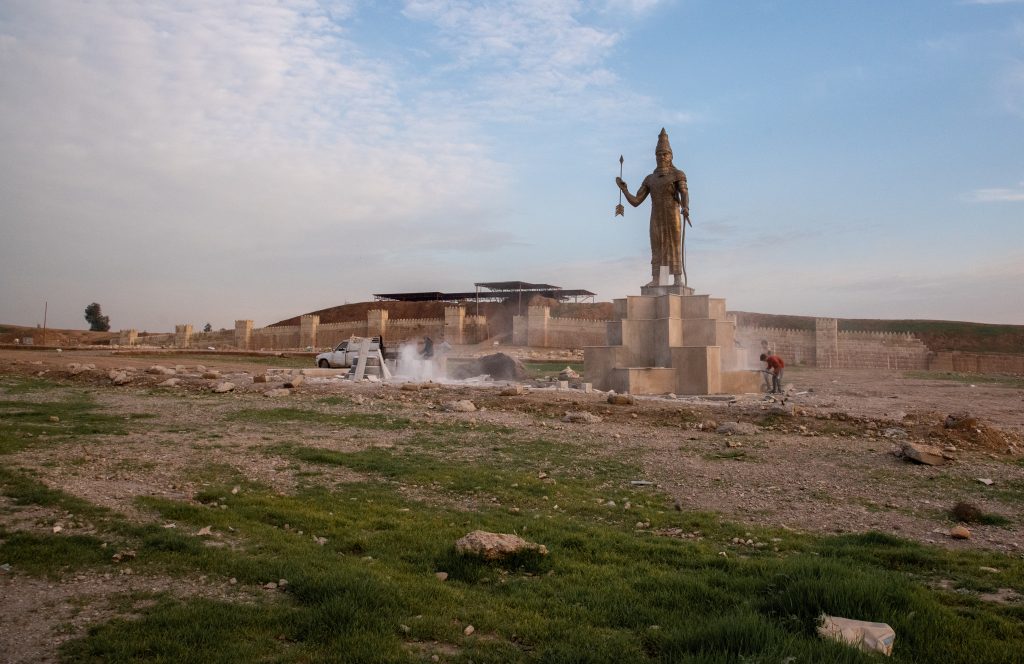
The King Synchrib Statue by sculptor Omar Kais. Credit: Ali Al-Baroodi
Art in public spaces is not only one of the oldest of all the arts, it is also the most public of the arts. In Iraq, it has been an integral and prominent part of urban culture for thousands of years and always invites people to connect with the place and its history in a new and special way. The return of the statues is one sign of the return of artistic life to Mosul and is considered a healing stage for the urban memory of the city.
To me, the return of the statues, and the return of art, is like the return of any other aspect of life. It may not be as important as rebuilding infrastructure, but it’s one part of us, and one part of the civil urban life we used to have. The statues aren’t just for Mosul, and for the people living there now, but they are there to tell our stories to visitors and to future generations.
Ali Al-Baroodi is a university teacher and photographer from Mosul.
[i] Author’s own experience
[ii] Monuments of Mosul in Danger. Accessed at: http://www.monumentsofmosul.com/index_htm_files/Monuments%20of%20Mosul%20in%20Danger.pdf; https://apimagesblog.com/blog/2017/7/14/mosul-drone-footage-destruction

This publication was produced as part of the XCEPT programme, a programme funded by UK International Development from the UK government. The views expressed do not necessarily reflect the UK government’s official policies.
